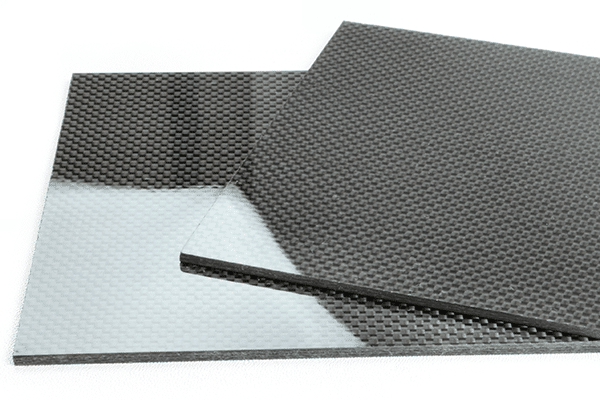Carbon fiber materials are becoming increasingly popular for medical equipment due to their mechanical strength, low weight, and excellent durability. Because of carbon fiber’s valuable combination of high tensile strength and low weight, it can be used to make various demanding medical devices that need to be both lightweight and strong. Additionally, its non-magnetic qualities reduce interference with any diagnostic imaging that requires magnetic resonance imaging (MRI) or other sensitive technology.
Definition of Medical Composites
When Aristotle observed in ancient Greece that “the whole is not the same as the sum of its parts,” he could have been describing the idea of a composite material: a material that consists of two or more distributed and active components and has a set of engineered properties different from any of the components in isolation.
Carbon fiber filaments, one element of a composite, are strands 5 to 10 microns in diameter (5 to 10 times smaller than a human hair) that consist of tightly interlocked chains of carbon atoms in a crystalline structure. These fibers are woven into a fabric that is then impregnated with a liquid resin that cures in a desired shape, creating a rigid structural material: roughly speaking, the fibers provide tensile strength to the composite, and the resin binds the fibers together in a matrix, supporting the fibers and transmitting forces between them.
This combination creates a rigid material with high tensile, compressive, and shear strength. Although the properties of carbon fiber itself receive much of the attention when describing how and why a carbon fiber composite behaves, factors such as the type of resin, the orientation of the fibers, and perhaps a core material sandwiched between two layers of fiber cloth are all available to the designer to meet design goals. Further, chemically inert composites that demonstrate biocompatibility are available for medical implants or devices that contact bodily fluids or tissue.
Why Carbon Fiber is an Excellent Composite for Medical Devices
Designers are drawn to carbon fiber composites for many reasons, but the primary advantage of carbon fiber is the high stiffness-to-weight ratio. For carbon fiber medical devices, this property solves many design challenges surrounding weight. Wheelchairs, other mobility devices, and prosthetic attachments are more effective and tolerable to the user if they are lightweight. Both surgeons and robots more accurately guide modern tools used in surgical procedures if they weigh less while also providing the necessary stiffness.
One of the leading chemical properties that medical equipment requires is resistance to corrosion and degradation. Carbon fiber composite materials easily withstand repeated high-temperature sterilization, prove to be unreactive to bodily fluids, and are non-corrosive. As a lightweight alternative to stainless steel, carbon fiber composites can replace materials traditionally used for products in medical applications where chemical resistance is essential and, in many cases, is superior.
Carbon fiber composites also show a high level of biocompatibility, making them ideal for biomedical applications. Not only have carbon fiber composites been shown to generate no cellular toxicity in in-vitro studies and only a non-specific foreign body reaction in animal studies, but their elastic modulus is close to that of bone.
This alignment makes carbon fiber composites more attractive than stainless steel or titanium for many bone implant device designs because of the reduced stress concentrations imparted on the interface between the bone and the implant. Carbon fiber composites can withstand higher strain loading and fatigue life than traditional implant materials – up to one million cycles in at least one study1.
Radiolucency is another coveted property that carbon fiber composites bring to the medical field. Because carbon fiber composites absorb only low levels of electromagnetic radiation energy and are non-magnetic; imaging technologies such as X-ray and MRI are more successful when imaging body areas near a composite implant. When the implant is made of a metallic substance, X-ray and MRI imaging near the site of the implant can be much more challenging.
The radiolucency property is also utilized in designing the apparatus that supports the patient in the imaging machines. Using carbon fiber composites for these structural members allow the radiation to pass through them without compromising the image gathered by the machine.
Applications of Carbon Fiber Medical Composites in the Medical Industry
A high strength-to-weight ratio compared to metals and excellent chemical resistance are the mechanical properties that make carbon fiber composites so valuable for use in prosthetic devices and surgical instruments. Often chosen for the “soft socket” material that mounts the prosthetic device to the limb, carbon fiber composites lend themselves to these custom mounts using a wet layup process formed around cast impressions or digital imaging data gathered from the individual.
Minimizing weight while maintaining adequate stiffness is a priority for prosthetics as it promotes greater use and reduces the difficulties that arise when they are too heavy. Carbon fiber composite materials’ light weight and stiffness facilitate the production of precision surgical tools. Hand tools such as forceps, retractors, and scissors can all be made from carbon fiber. Tools for robotic surgery are made lighter and stiffer with carbon fiber composites. Carbon fiber robotic arms move more quickly and precisely with smaller motors.
Bone implant devices made from carbon fiber composite materials meet needs that range from dental, cranioplasty, and maxillofacial implants to scaffolds for tissue engineering. For example, orthopedic stabilization with metal plate implants is a surgical procedure typically employed to repair bone tumor legions and areas of bone removal or fractures and is often followed up with post-surgery radiotherapy or radiofrequency imaging complicated by the metal implant. Implantable carbon fiber composites, causing neither scattering of radiotherapy dosing nor interfering with radiofrequency imaging, are an ideal replacement for metal implants because the surgeon can see all sides of the bone.
If operating close to a joint, the radiolucency of the carbon fiber implant reduces the risk of screw perforation. Additionally, using carbon fiber composites for bone implants alleviates the concerns for complications from metal allergies as they have been shown to be highly biocompatible.
Radiotherapy centers can improve soft-tissue cancer treatment targets by combining CT and MR images but require precise patient positioning during imaging and treatment. The treatment couches – the platform that slides a patient into the MRI or CTI machine – and the immobilization devices attached to the couch use carbon fiber composites for their lightweight rigidity and strength, but also because the carbon fiber couch is invisible to the imaging processes.
Frequently Asked Questions
Is Carbon Fiber biocompatible?
Carbon fiber composites generate no cellular toxicity in in-vitro studies and only a non-specific foreign body reaction in animal studies. Also, its elastic modulus can be close to bone, improving its biocompatibility for spinal reconstruction and other skeletal repair applications.
Is Carbon Fiber safe for humans?
Carbon fiber fabric is inert and poses no risk to humans, and when the resin has cured, the composite material is also inert. One should wear personal protective equipment when sanding, cutting, or shaping a carbon fiber composite because the dust could become respirable and inhaled into the lungs. For people handling uncured epoxy resins when making carbon fiber composites, precautions should be taken as recommended by the manufacturer of the resin material to minimize skin contact with the uncured resin.
What are the factors influencing the growth of the medical composites market?
The global medical composites market is a high-growth market valued at $1.4B in 2023 and projected to reach $1.7B by 2027, exhibiting a compound annual growth (CAGR) of 8%. The driving factors for this growth are a) the increasing demand for lightweight and radiolucent materials, b) a high rate of technological development in medical implants using composite materials, and c) the growing demand for minimally invasive surgery. The diagnostic imaging segment of the medical composites market drives the current demand because the material is used to make multiple imaging machines and accessories components.
What are the challenges in the medical composites market?
Manufacturing costs for carbon fiber medical devices are a primary concern for market penetration. Raw material cost is a focus. Various prepreg preparations (fabric that is pre-impregnated with the uncured epoxy resin) and faster curing resins have been developed to drive costs. Production technology is also working to reduce cycle times through new forming processes, fabric preparation techniques, and more. Finally, advanced software tools are reducing engineering costs and design iteration times.
What is the biggest restraint in the medical composites market?
Strict clinical and regulatory processes make up the major restraint in the medical composites market. The approval of carbon fiber medical devices and their materials is a slow process regulated differently in the major market locations – the FDA in the United States and the European Commission in Europe – which adds complexity to an already complicated process.
[1] Rui Guo et al., “The fatigue performances of carbon fiber reinforced polymer composites – A review,” Journal of Materials Research and Technology 21 (2022/11/01/ 2022), https://doi.org/10.1016/j.jmrt.2022.11.053, https://www.sciencedirect.com/science/article/pii/S2238785422017598.





